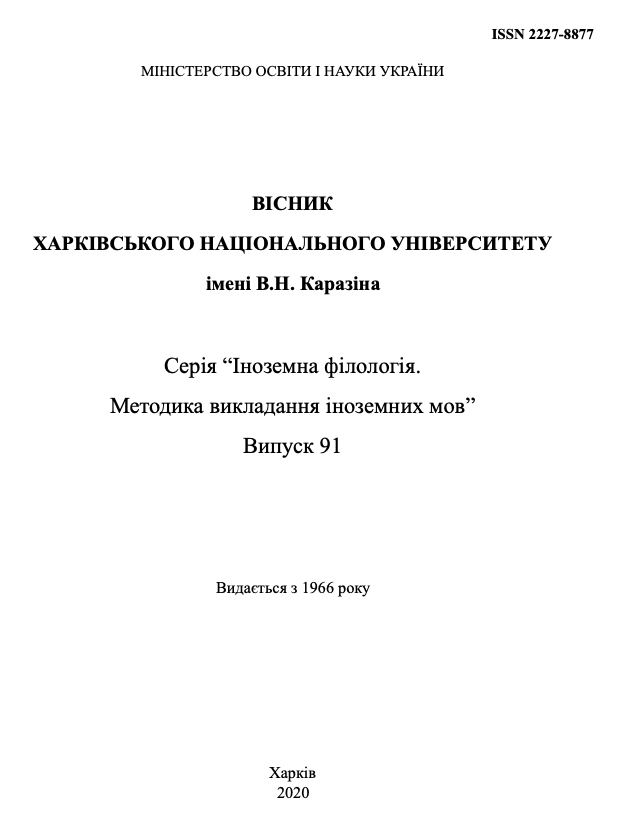МОВНІ ОСОБЛИВОСТІ СЕРЕДНЬОВЕРХНЬОНІМЕЦЬКОЇ ДІЛОВОЇ ПРОЗИ
Анотація
В даній статті розглянуто ділові папери XII-XIII ст. з міста Аугсбурга, що на півдні Німеччини. Норма сучасної німецької мови пройшла кілька етапів формування перед тим, як набути уніфікованого стандарту та стати так званою Standardsprache. Місто Аугсбург належить до східнобаварської діалектної області та розташовано на кордоні Баварії і Швабії. Аналіз писемної мови документів XII-XIII ст. надав інформацію про взаємодію особливостей обох діалектів (баварського і швабського). В даному дослідженні було розглянуто 5 документів, пов'язаних з різноманітними податками, які свідчать про те, що вони були написані в Аугсбурзі, а також 3 документи з Аугсбурзького монастиря. Важливим є те, що для розглянутих документів немає характерної послідовності у написанні, тобто відсутність орфографічної норми. Підтвердження даного факту також наведені в статті з прикладами вивчених матеріалів. Проведене дослідження показало наявність схожих ознак в усіх досліджених діалектах, що свідчить про їх безперечну мовну спорідненість. Не зважаючи на це, зустрічаються й риси, характерні суто для південно-західної частини Німеччини та окремо для південно-східної. Аналіз німецьких південних діалектів дає можливість простежити тенденцію розвитку німецької мови в її свн. періоді, який тісно пов’язаний з історією німецького народу. Розглянуті процеси синергії між діалектами в рамках однієї мови упереджено звертає увагу на початок формування спочатку мови народної, а згодом – національної. В ході дослідження виявлено, що Аугсбург став своєрідним провідником баварського діалекту у східній частині швабського діалекту. Досліджені ізоглоси (фонетичні, морфологічні, лексичні) показали, що зазначенні діалекти можна об’єднати у мовному відношенні як південні і вважати особливістю германського (ермінонського) ареалу. Не дивлячись на деякі мовні розходження, відмічається відносна єдність мовних традицій, що свідчить про достатню близькість діалектів південно-західної та південно-східної частини Німеччини у XII-XIII ст.
Завантаження
Посилання
Arsen'eva M. G., Balashova S. P., Berkov V. P., Solov'eva L. N. Vvedenie v germanskuju filologiju. Moskwa : GIS, 2000. 314 s. (in Russian)
Golubenko L. M., Kulyna I. G., Kozak T. B.Vstup do germans`koyi filologiyi. Prakty`kum do kursu. Odesa: Feniks, 2019. 152 S. (in Ukrainian)
Golubenko L.M., Kulyna I.G., Berezina Yu.O. Istorija nimets`koyi movy`. Prakty`kum z kursu. Odesa: Feniks, 2017. Ch. II. 36 s. (in Ukrainian)
Guhman M.M. Ot jazyka nemeckoj narodnosti k nemeckomu nacional'nomu jazyku. – Iz-vo Akademija Nauk SSSR, Moskva, 1955. Ch. I. 164 s. (in Russian)
Dombrovan T.I. Sinergeticheskaja model' razvitija anglijskogo jazyka. KP OGT Odessa, 2014. 399 s. (in Russian)
Zhirmunskij V.M. Istorija nemeckogo jazyka. Moskva, 1965. 299 s. (in Russian)
Zhirmunskij V.M. Nemeckaja dialektologija. Moskva, Akademija nauk SSSR, In-t jazykoznanija, 1956. 635 s. (in Russian)
Levic'kij V. V. Osnovi germanіstyki. Vіnnicja: Nova Kniga, 2008. 528 s. (in Ukrainian)
Levickij V. V. Etimologicheskij slovar' germanskih jazykov. Vinnica: Nova Kniga, 2010. t.1. 616 s., t.2. 368 s. (in Russian)
Moskal'skaja O. I. Istorija nemeckogo jazyka. Moskva: Akademija, 2006. 2-e izd. 288 s. (in Russian)
Selіvanova O.O. Lіngvіstichna enciklopedіja. Poltava, Dovkіllja-K, 2010. 843 s. (in Ukrainian)
Taranec' V. G. Dіahronіja movi: Zbіrka statej. Odesa: Drukars'kij dіm, 2008. 232 s. (in Ukrainian)
Udal'cov A.D. Drevnie germancy. Moskva: MGU, 1937. 222 s. (in Russian)
Das Herkunftswörterbuch. Etymologie der deutschen Sprache. Duden-Mannheim, Leipzig, Wien, Zürich: Dudenverlag, 2006. B.7. 4 Aufl. 960 S. (in German)
W. Fleischer. Wortbildung der Deutschen Gegenwartsprache. Moskwa, 1990. 412 S. (in German)
Helbig G., Buscha J. Deutsche Grammatik. M., 1972. 483 c. (in German)
Schmidt W. Geschichte der deutschen Sprache S. Hirzel Verlag, Stuttgart, 2007. 10. Aufl. 489 S. (in German)
Sonderegger S. Althochdeutsche Sprache und Literatur. Berlin, New York: Walter de Gruyter, 2003. 390 S. (in German)




